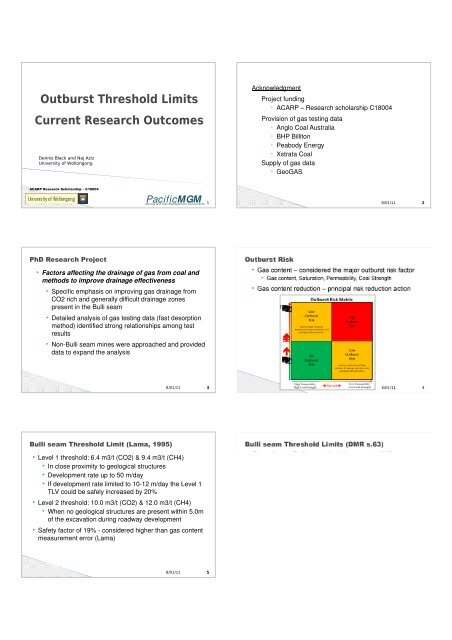Outburst Threshold Limits - University of Wollongong
Outburst Threshold Limits - University of Wollongong
Outburst Threshold Limits - University of Wollongong
Create successful ePaper yourself
Turn your PDF publications into a flip-book with our unique Google optimized e-Paper software.
<strong>Outburst</strong> <strong>Threshold</strong> <strong>Limits</strong><br />
Current Research Outcomes<br />
Dennis Black and Naj Aziz<br />
<strong>University</strong> <strong>of</strong> <strong>Wollongong</strong><br />
ACARP Research Scholarship – C18004<br />
PhD Research Project<br />
PacificMGM<br />
▸ Factors affecting the drainage <strong>of</strong> gas from coal and<br />
methods to improve drainage effectiveness<br />
▸ Specific emphasis on improving gas drainage from<br />
CO2 rich and generally difficult drainage zones<br />
present in the Bulli seam<br />
▸ Detailed analysis <strong>of</strong> gas testing data (fast desorption<br />
method) identified strong relationships among test<br />
results<br />
▸ Non-Bulli seam mines were approached and provided<br />
data to expand the analysis<br />
Bulli seam <strong>Threshold</strong> Limit (Lama, 1995)<br />
Acknowledgment<br />
Project funding<br />
• ACARP – Research scholarship C18004<br />
Provision <strong>of</strong> gas testing data<br />
• Anglo Coal Australia<br />
• BHP Billiton<br />
• Peabody Energy<br />
• Xstrata Coal<br />
Supply <strong>of</strong> gas data<br />
• GeoGAS<br />
Mining and Gas 8/01/11 Management Consultants 1 8/01/11 2<br />
8/01/11 3<br />
▸ Level 1 threshold: 6.4 m3/t (CO2) & 9.4 m3/t (CH4)<br />
▸ In close proximity to geological structures<br />
▸ Development rate up to 50 m/day<br />
▸ If development rate limited to 10-12 m/day the Level 1<br />
TLV could be safely increased by 20%<br />
▸ Level 2 threshold: 10.0 m3/t (CO2) & 12.0 m3/t (CH4)<br />
▸ When no geological structures are present within 5.0m<br />
<strong>of</strong> the excavation during roadway development<br />
▸ Safety factor <strong>of</strong> 19% - considered higher than gas content<br />
measurement error (Lama)<br />
8/01/11 5
<strong>Outburst</strong> <strong>Threshold</strong> <strong>Limits</strong> – Recent Changes<br />
▸ Two Bulli seam mines have increased outburst TLV<br />
• New TLV in place for about 5 years<br />
• No outburst incidents (where gas content reduced below TLVs)<br />
• Effective outburst management plans<br />
▸ TLV (normal mining) – effectively unchanged<br />
▸ Additional TLVs added – subject to additional controls<br />
▸ Not greater than the Level 2 TLV proposed by Lama (1995)<br />
Additional controls:<br />
• Increased drilling<br />
density<br />
• Restricted mining rate<br />
• Increased coal core<br />
sampling & analysis<br />
<strong>Outburst</strong> <strong>Threshold</strong> <strong>Limits</strong><br />
1995-2000<br />
▸ TLV very effective in managing outburst risk<br />
▸ No fatalities since introduction <strong>of</strong> TLV<br />
▸ Prevailing mine conditions enabled relatively easy<br />
compliance – TLV generally accepted<br />
2005-2010<br />
▸ Mines are encountering more difficult conditions<br />
• Additional drilling<br />
• Production delays<br />
• Loss <strong>of</strong> reserves<br />
▸ TLV now being questioned - considered conservative<br />
▸ Reviews underway to support raising TLVs<br />
▸ Are the 1995 s.63 TLV’s really too conservative?<br />
Significant Questions<br />
8/01/11 8<br />
1. Given recent increases to Bulli seam TLV should<br />
the DRI methodology be reviewed?<br />
2. Does DRI900 continue to be an appropriate basis<br />
for determining TLV for non-Bulli seam mines?<br />
3. Has the relationship between Gas Content and<br />
DRI, for CH4 and CO2 changed (from 1995)?<br />
4. Is the relationship between Gas Content and<br />
DRI, for CH4 and CO2 representative <strong>of</strong> all Bulli<br />
seam conditions?<br />
8/01/11 9 8/01/11 10<br />
Relationship between Gas Content and DRI<br />
▸ Does the Gas Content V DRI relationship (CO2 & CH4)<br />
remain valid for current Bulli seams conditions<br />
▸ Extensive analysis <strong>of</strong> core sample gas content test results<br />
▸ Representative dataset compiled<br />
• 8 Australian undergrounds mines<br />
• 4,785 samples<br />
Mine Reference State Samples DRI Data Gas Composition<br />
Mine A NSW 527 No Mixed CH 4 - CO2<br />
Mine B NSW 414 No Mixed CO 2 - CH4<br />
Mine C NSW 770 Yes Mixed CO 2 - CH4<br />
Mine D QLD 1,047 Yes CH 4<br />
Mine E NSW 441 Yes CO 2<br />
Mine F QLD 383 Yes CH 4<br />
Mine G QLD 393 Yes CH 4<br />
Mine H QLD 810 Yes CH 4<br />
TOTAL SAMPLES<br />
4,785<br />
• Gas composition >90% CH4 – 575 samples<br />
• Gas composition >90% CO2 – 2,903 samples<br />
8/01/11 12
Conclusions<br />
▸ Extensive data analysis – 8 mines & thousands <strong>of</strong> samples<br />
▸ Analysis indicates DRI900 is no longer a valid index value<br />
for determining TLV for non-Bulli seam mines<br />
▸ Strong relationship between QM and DRI<br />
▸ Independent <strong>of</strong> coal properties, including gas composition<br />
▸ QM = 0.008 x DRI applies to 6 mines analysed<br />
▸ Separate DRI values for CH4 and CO2 TLV<br />
▸ TLV applicable to the Bulli seam is directly transferrable to<br />
non-Bulli seam mines<br />
▸ Areas requiring further research<br />
▸ Expand QM-DRI database – additional Australian underground<br />
mines<br />
▸ Analyse mining experience in areas <strong>of</strong> high gas content (close to<br />
and above current TLV)<br />
8/01/11 16

















